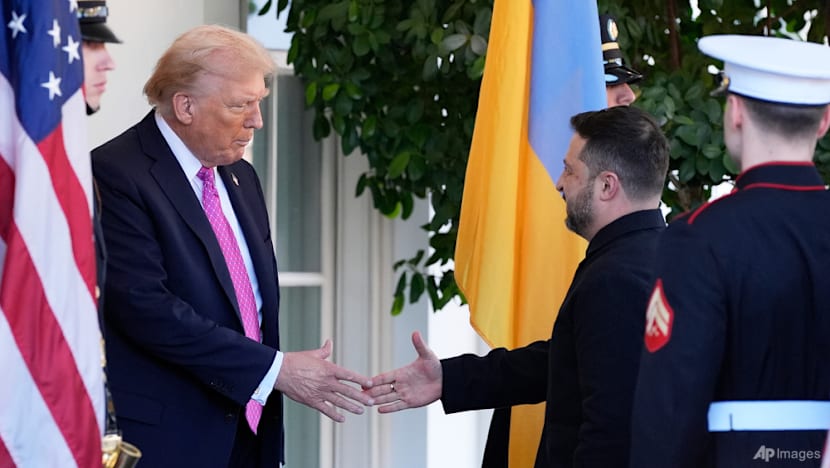Commentary: Every time Putin calls, Trump caves in and the Ukraine war grinds on
If the Kremlin’s objective was to get Donald Trump to back off selling Tomahawks to Ukraine, it seems that Vladimir Putin has succeeded, says international security professor Stefan Wolff.

President Donald Trump, left, greets Ukraine's President Volodymyr Zelenskyy at the White House, Oct 17, 2025, in Washington. (AP Photo/Alex Brandon)

This audio is generated by an AI tool.
BIRMINGHAM, England: Ukrainian President Volodymyr Zelenskyy arrived at the White House on Friday (Oct 17) hoping to secure long-range Tomahawk missiles that United States President Donald Trump had recently said he was considering supplying to Kyiv.
He left empty-handed, his hopes thwarted by a surprise, lengthy phone call between Mr Trump and Russian President Vladimir Putin while Mr Zelenskyy was en route to Washington.
In his two-hour conversation with Mr Putin, the Russian leader warned Mr Trump again that sending such weapons would “damage relations” between US and Russia. He also piled on the praise for Mr Trump’s peace efforts in the Middle East and offered the prospect of another high-profile summit, this time in Budapest.
Hours later, at his meeting with Mr Zelenskyy, Mr Trump said the Tomahawks were “a big deal” and that the US did not want to “be giving away things that we need to protect our country”. He also called on both sides “to stop the killing, and make a DEAL!”
The shift in tone was unmistakable. During two phone calls between Mr Trump and Mr Zelenskyy the previous weekend, the two presidents apparently discussed the terms of American supply and Ukrainian use in some detail. This followed an apparent shift by Mr Trump in late September when he suddenly announced that he thought Kyiv was “in a position to fight and WIN all of Ukraine back in its original form.”
Clearly frustrated with his inability to push Russia and Ukraine to make a deal, it looked like Mr Trump was decisively pivoting towards Kyiv and considering approving Mr Zelenskyy’s requests for long-range strike capabilities. These discussions clearly had the Kremlin sufficiently worried to reach out to the White House and request the phone call between Mr Trump and Mr Putin.
KYIV LEFT WAITING AGAIN
If the Kremlin’s objective was to take Tomahawks off the table and re-engage more positively with Mr Trump, it seems that Mr Putin has succeeded. At least for the time being, there is no sign that the US will imminently deliver Tomahawks to Ukraine.
There has always been some doubt about the ability of the US to deliver them in the quantities needed by Ukraine. And as they are now mostly used by the US Navy, there was uncertainty about the availability of sufficient land-based launchers as well.
While their range and destructive potential would have provided a significant uplift to Ukraine’s ability to strike military targets deep inside Russia, it is far less certain that they would have proven to be the kind of game-changer to force Russia into meaningful negotiations with Ukraine.
They would have complemented existing Ukrainian capabilities and extended their range, enabling Ukrainian forces to attack command centres, air bases, logistics hubs, training grounds and military supply lines far behind the front lines.
But it would probably have required dozens, if not hundreds, of successful strikes to put decisive pressure on Mr Putin. These strikes would have had to be executed in quick succession to prevent Russian air defence systems from adapting. And there would have needed to be a credible threat of a sustained campaign. All of this now seems an even more remote possibility.
PUTIN SHAPES THE TERMS
However, what is more significant is the symbolism behind Mr Trump’s conversations with Mr Putin and Mr Zelenskyy. The Russian president still seems to retain the ability to do just enough to prevent Mr Trump from decisively throwing his weight behind Ukraine’s war effort. If nothing else, he has bought Russia yet more time to pursue its war against Ukraine.
A new round of high-level talks between American and Russian officials is about to commence this week, with the US delegation to be led by Mr Trump’s Secretary of State and National Security Advisor Marco Rubio. Mr Trump and Mr Putin agreed that they would then meet in person “to see if we can bring this ‘inglorious’ War, between Russia and Ukraine, to an end”.
No clear timeline has been attached to these talks, and no deadline has been set for a presidential summit. Not that deadlines and ultimatums have mattered much in the past, but not having any gives Mr Putin even more room to try and wear Ukraine down by continuing his attacks against critical infrastructure and making further territorial gains along the frontlines in Ukraine’s Donbas region.
It also means that any ceasefire is off the table for now, as are direct negotiations between Ukraine and Russia. If anything, we are now much closer again to Mr Putin’s likely preferred scenario of negotiating an end to the war against Ukraine through a deal with the US, thereby cutting out both Kyiv and its European allies.
It is not clear how Mr Putin managed to resell this idea to Mr Trump, but the fact that he apparently has underscores the volatility of Mr Trump’s approach to ending the war. What is more, Mr Putin may not even want, let alone need, his latest ploy to work. He is still convinced that because of Russia’s manpower advantage, Moscow can ultimately defeat Ukraine militarily. All he needs to do this, and has just done again, is keep the US out of the war.
Stefan Wolff is Professor of International Security at the University of Birmingham and Head of the Department of Political Science and International Studies.
















